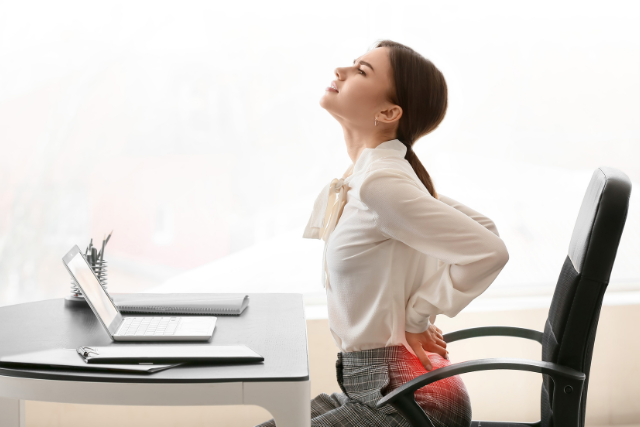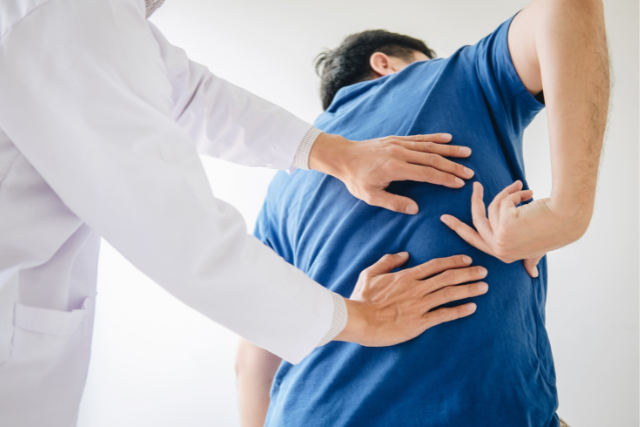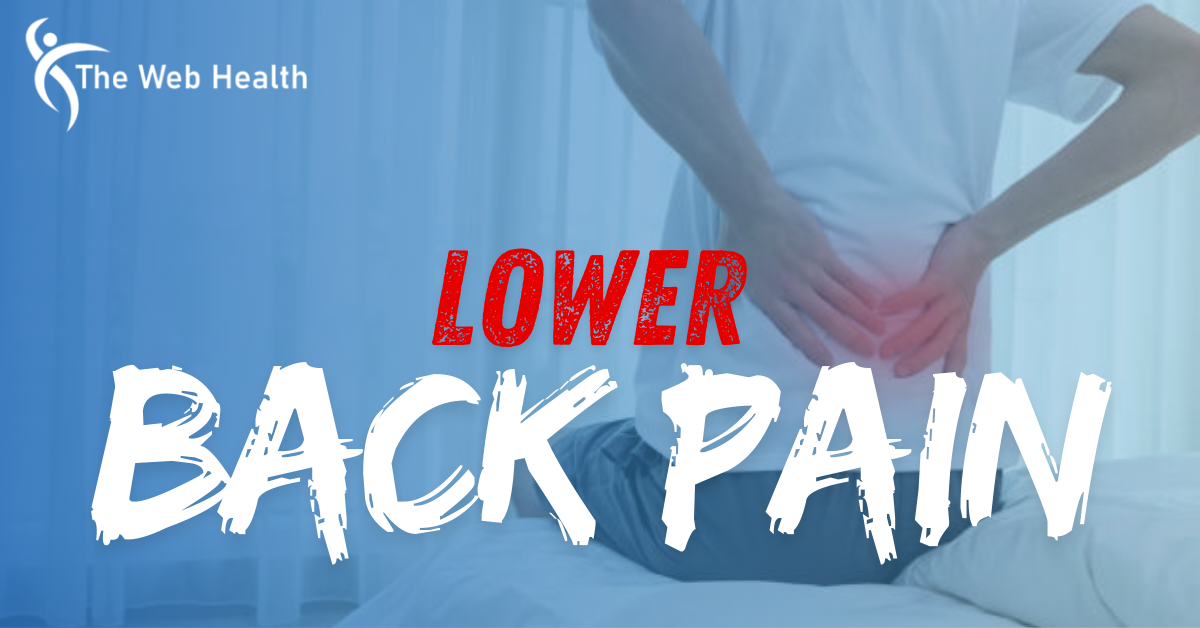Lower back pain is one of the most common health problems nowadays. Nearly 80% of adults face it at some point in their lives.
A sudden pull or stretch in the muscles is usually what starts lower back pain. But problems like joint wear or a slipped spine can also cause it. The pain might feel like a dull ache or a sharp sting and can stay all the time or come and go.
Below, we’ll explain the causes of lower back pain and how to handle it in simple ways.
What is Lower Back Pain?
Let’s first understand what lower back pain is.
Lower left back pain affects the area below your ribs, called the lower spine. It’s a common issue, and almost everyone faces it at some point of the age. It’s a leading reason for missing work in the United States, affecting about 84% of people each year. While it often gets better on its own, ongoing pain should be checked by a doctor.
Lower Back Pain Symptoms
Low back pain is a common issue with no specific signs or symptoms that distinguish it from other forms of chronic pain.
It may feel like a mild, steady ache or sharp, sudden pain. It can affect walking, standing, and other daily movements. Pain can occur at any age and may be acute, resulting from exercise, sports, strains, or hard physical work, or long-term, lasting more than three months. If your pain doesn’t go away within three days, you should consult the doctor.
Symptoms Demanding Immediate Attention
- If you hurt your back in an accident or fall.
- If your back pain comes with problems going to the bathroom (peeing or pooping).
- If your legs feel weak or numb.
- If you have a fever along with back pain.
- If your back hurts when you cough.
These could be indications of a serious condition; you should seek medical attention early.
Now, what about causes? Let’s discuss them below.
Lower Back Pain Causes

Muscle Strain vs. Sciatica
Back pain is often caused by muscle strain from lifting or doing hard tasks. But sometimes, the soft discs between the bones in your spine can slip or break. This can press on nearby nerves. The discomfort may radiate from the lower back to the leg if the sciatic nerve is compromised. This is known as sciatica.
Jobs and Your Back
Many kinds of work can cause back pain. If your job involves heavy lifting, pulling, or twisting, your back can get sore. Back problems can also happen if you sit in a chair for a long time without good support.
Bags and Backaches
It is bad for your back to carry a big bag on one shoulder. Both your body weight and the weight of the bag must be supported by your lower back. Your back may be strained if the bag is too hefty. Using a wheeled bag can have a significant impact.
Exercise and Back Pain
Exercise is good for your body, but too much can hurt your back. People who don’t stay active during the week and then do a lot of tough exercise on the weekend often end up with back pain.
Posture Matters
The way you sit and stand plays a major role in back health. Your spine will be under more strain if you slouch. Try to sit up straight with your back well supported. When standing, keep your weight balanced on both feet.
Herniated Discs
Your spine has soft cushion between the bones called discs. Over time, these discs may deteriorate or sustain damage from an accident. When a disc is damaged, it can press on nearby nerves and cause severe pain. This is known as a herniated disc.
Age-Specific Lower Back Pain Concerns
Younger Adults (20 to 40)
Back pain in younger adults is often caused by physical stress, bad posture, or sports injuries, or workouts. Using proper lifting methods, improving posture, and doing exercises to build strength can help prevent and reduce pain.
Middle-Aged Adults (40 to 60)
As we get older, the spine naturally starts to wear out. The discs between the bones may thin, and the back may become less flexible, leading to more pain. Doing core exercises and low-impact activities like walking or swimming can help keep the spine healthy.
Older Adults (60+)
Older adults are more likely to have problems like spinal narrowing and weak bones, which lead to back pain. Exercises that improve balance, flexibility, and bone strength, like yoga and light strength training, are very helpful at this age.
Chronic Conditions and Back Pain
Several long-term health problems can lead to lower back pain:
Spinal stenosis: This occurs when the space inside the spine narrows and puts pressure on the nerves, resulting in discomfort.
Ankylosing spondylitis: This is swelling in the joints of the spine. It can also affect the shoulders, hips, and ribs. It causes ongoing back pain and stiffness. In serious cases, it can cause the bones in the spine to join together.
Fibromyalgia: This condition causes pain all over the body, including the back.
These are some common causes. However, other reasons can also lead to lower back pain.
Other causes
Lower back pain can sometimes point to health problems that aren’t directly related to the spine. Possible causes includes:
- Abdominal aortic aneurysm
- Endometriosis
- Kidney stones
- Pregnancy
- Cancer
Risk Factors for Lower Back Pain
Lower back pain is a common problem, especially as you get older. It often begins around age 30, and the chances of it coming back go up with age. In some cases, people may wonder, Can a urine infection and gas cause lower back pain? The answer is yes, urinary infections, especially if they reach the kidneys, can lead to pain in the lower back area.
What makes you more likely to get lower back pain?
- Age: As you get older, your spine goes through more wear and tear.
- Weight: Having extra body weight puts additional strain on your back.
- Lack of exercise: Weak back and belly muscles can make your back more susceptible to injury.
- Jobs with heavy lifting or bending: These kinds of work can strain your back.
- Smoking: Smoking can harm the soft discs between the bones in your spine.
- Poor posture: Slouching or sitting the wrong way can stress your back.
- Medical conditions: Problems like arthritis or weak bones (osteoporosis) can raise your risk.
Diagnosing Lower Back Pain

If you have lower back pain, it’s important to consult with a doctor to diagnose what’s causing it. The doctor will ask you questions like when the pain started, where it hurts, and what makes it better or worse.
Sometimes, the doctor may want to take pictures of your back to look for any problems. This can be done using X-rays, CT scans, or MRI. However, these tests are not always needed in the beginning. Based on your symptoms, your doctor will decide if you need any of these tests. In some cases, using proper shoes for lower back pain can also help improve posture and reduce strain, so your doctor may recommend supportive footwear as part of your care.
Natural Treatment for Low Back Pain
Back ache or low back ache is a common complaint with different causes, and one of the natural ways to treat it is by carrying out the following activities:
Rest is Not Best
Sometimes when you have back pain, all you want to do is rest, but that’s not always the best thing to do. Doctors say it’s better to get back to your usual activities quickly. If you stays in bed for more than a few days, your pain may get worse, and your muscles may get weaker.
You might want to lie in bed when your back hurts, but this isn’t always a good idea. Doctors say it’s better to return to your daily tasks as soon as you’re able. If you remain in bed for more than a few days, your back may hurt more, and your muscles may lose strength. Finding the best sleeping position for lower back pain can also help reduce discomfort and support healing.
Warm it Up
Heat can help soothe back pain. You can use a warm water bottle or take a hot bath. Heat helps loosen tight muscles and gives short-term relief that makes you feel more comfortable.
Yoga Can Help
If your back pain lasts more than three months, yoga could be a good choice. Research shows people who do yoga for 12 weeks feel less pain than those who don’t. Yoga builds strength and flexibility, but you should learn it from a trained teacher.
What About Chiropractic and Massage?
Some people go to chiropractors or massage therapists for back pain. Chiropractors try to fix the bones in your spine. Massage can help relax your muscles. There’s some evidence that massage can help with long-term back pain, especially if you also do exercises and stretches. If you experience back pain from running lower back, these treatments combined with proper exercise might offer relief.
Acupuncture: Does it Work?
Acupuncture is a process that involves the use of tiny needles inserted into the skin. Some people believe it helps relieve back pain. However, research shows it’s unclear whether acupuncture works better than fake acupuncture for sudden back pain. But it may help with long-term (chronic) back pain. If you experience lower back pain when bending over, acupuncture might be worth trying as part of your treatment plan.
Lower Back Pain Medication
For mild lower back pain, over-the-counter medicines like Tylenol, Advil, or Aleve can help. These drugs, called NSAIDs, reduce swelling and pain. You can also use creams or gels with menthol or capsaicin to ease pain in your back. If you experience lower back pain and nausea, it’s important to monitor your symptoms and see a doctor, as this combination may need further medical attention.
When to Consult with the Doctor
If over-the-counter medicines don’t help to relieve your pain after a few weeks, or if your pain gets severe, you should visit the doctor. They can find out what’s causing the pain and give you the right treatment.
What Else Can Help?
Injections: If other treatments don’t work, your doctor may give you a corticosteroid shot. This medicine can reduce swelling and ease pain for a while.
Surgery: Only a few people need surgery for lower back pain. It’s usually for severe pain that doesn’t get better. Surgery may involve removing a damaged disc, making more space for the spinal cord, or joining bones together.
Physical Therapy: Physical therapy can be very helpful for lower back pain. A physical therapist can teach you exercises to strengthen your core and back muscles, improve movements, and fix poor posture. Studies show physical therapy helps people feel better and move more easily. It is also an effective way to do lower right back pain exercises.
Get Stronger
Building strong core and back muscles is important to prevent and manage lower back pain. Exercises like planks, bridges, and back extensions can help. But it’s important to do them correctly to avoid injury. Ask a physical therapist or doctor to teach you how to do these safely.
Preventing Low Back Pain
You can’t completely avoid low back pain as you age, but some steps can lower your risk:
- Maintain a healthy weight: Extra weight puts pressure on your spine. Losing even a little can help. A study showed that losing 10 pounds cuts back pain in half for overweight people.
- Move regularly: Exercise strengthens your core muscles that support your back. Aim for 150 minutes of moderate exercise each week. Walking, swimming, and yoga are good choices.
- Lift smart: Bend your knees and use your legs, not your back, when lifting. This reduces strain on your spine. Technique is more important than strength.
- Check your workspace: If you sit a lot, make sure your chair supports your lower back and your feet rest flat on the floor. Your monitor should be at eye level to avoid neck and back strain.
Last Words
Lower back pain is common, but you can prevent or control it. Avoid being inactive, keep good posture, and lift heavy things carefully to protect your back.
If your pain doesn’t get better or gets worse, visit a doctor to get the best treatment.


